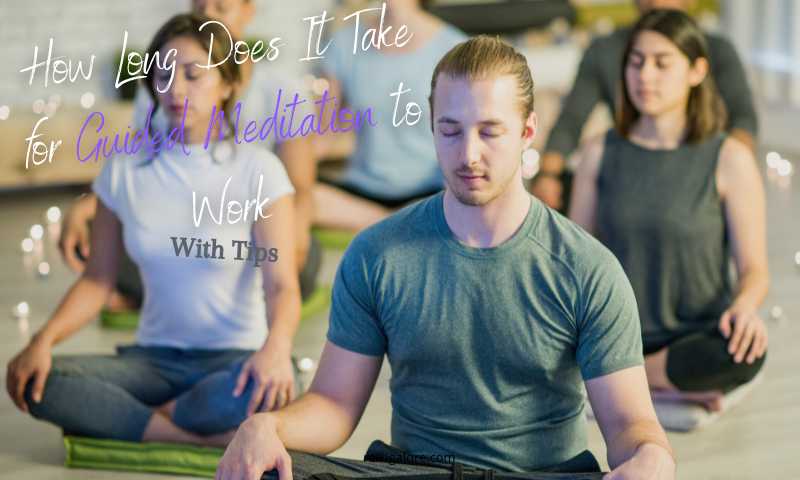You’re not sure if guided meditation is right for you, and you’re not sure how long it will take before you see any results.
Guided meditation can be a powerful tool for self-improvement, but it’s important to be patient and give yourself time to acclimate to new practices.
Remember that practice makes perfect, so the more you meditate, the better your results will be.
While there is no one-size-fits-all answer to the question of how long it will take for a guided meditation to “work,” there are a few factors that can provide insight into what kind of impact you might experience over time.
Here are some key elements that help determine how quickly you can expect results from guided meditation:
-Your motivation
-Your physical environment
-The quality of your instruction
-The amount of time devoted to practice
-Your consistency in practice

Benefits of Guided Meditation
Guided meditation has been shown to have numerous potential benefits including reducing stress, improving focus, boosting confidence, and improving overall well-being.
By listening to expert instruction and following simple breathwork techniques, guided meditations can help a person achieve a state of relaxation and mindfulness more quickly.
Regular practice of guided meditations can also be beneficial in the long term.
The process of relaxation helps people reduce their mental stress, which can cause physiological changes in the body that lead to improved health outcomes such as reduced blood pressure and improved sleep patterns.
Furthermore, due to its calming effect on the mind, guided meditation may assist with learning and remembering information better.
There is no single timeline that applies to everyone who practices guided meditation — while many feel results almost immediately, others may require more regular exposure to meditation before they begin noticing any changes in their mood or behaviors.
Finding an experienced teacher or guide who is knowledgeable about tailored approaches for each individual can be helpful in managing expectations about the process of mindfulness.
Types of Guided Meditation
Meditation has been practiced for centuries, and there are many different types of meditation.
Each type of guided meditation is designed to help you achieve a specific goal or practice while also helping you to relax and reduce stress.
There are many types of guided meditations available to choose from, some focusing on relaxation, others on visualization, and even those that focus on specific topics such as money, love or success.
Some common types include:
- Breathing meditation: concentrates on controlling your breathing rate in an effort to slow it down and focus your awareness.
- Mindfulness meditation: uses mindful awareness techniques where you focus intently on the present moment over a period of time without judgment to help reduce stress levels.
- Visualization meditation: combines visual aids with mindfulness techniques to help create a desired outcome in your life such as improved health or greater abundance.
- Loving-kindness meditation: uses the energy of unconditional love to bring about peace and understanding within yourself and for those around you.
- Transcendental meditation: utilizes mantras or special sounds that are repeated throughout the session in order to bring about more profound states of awareness.
- Chakra Meditation: a form of yogic practice which involves focusing on specific points along the body’s seven chakras in order to reach deeper levels of consciousness.
How Guided Meditation Works
Guided meditation is an effective mind-body tool for relaxation and stress management that involves an instructor or other sound source providing verbal directions guiding your attention to a particular thought, object, or activity.
The goal of guided meditation is to achieve a deeper state of relaxation, which makes it beneficial for managing stress and anxiety.
During guided meditation, you’re usually directed to focus your attention on breathing and physical sensations in the body.
To support this effort, you may be asked to take slow deep breaths or tense different muscle groups while allowing smooth exhalations.
In some cases, you can be asked to imagine yourself in a peaceful place or be given specific thoughts and images to focus on.
Typically, the process begins with relaxation techniques such as exercising mindfulness by focusing on breath work and visual cues before easing into the deeper meditative states of quietness and stillness that add up over time.
The duration can range from five minutes for beginners who simply want to practice calming their minds enough so they can drift off at night time, to sessions up to 30 minutes in length with experienced meditators who are looking for more spiritual reflections;
However, most people opt for 10–15 minutes sessions which are proven to be very effective.
The effects of regular guided mediation practice vary depending on the person but overall a feeling of greater well-being is usually reported with increased mental clarity, emotional balance and deepened inner peace being typical outcomes over time.
Long-term practitioners report even greater benefits with enhanced appreciation of life situations along with improved relationships with others being observed in those who have entrenched mediation practices over time.
Factors Influencing the Effectiveness of Guided Meditation
Guided meditation is a form of mindfulness meditation involving the use of an instructor or teacher to help the participant understand and experience the various aspects of the practice.
While this type of guided practice can provide many benefits, it is important to recognize that these results can be influenced by a number of different factors.
The effectiveness of guided meditation depends on several elements, including the skill and experience level of your teacher/guide, how regularly you meditate, your ability to stay focused during your session, and other lifestyle factors.
To maximize its potential benefits, it is important to consider all aspects as you explore what works best for you.
In general, it takes time for guided meditation to work — depending on your individual practice and circumstances, results may not be seen or felt immediately.
A positive environment is key — having patience and finding a comfortable space allow for a more productive experience through which you can gain better insight into your own thought patterns and behaviors over time.
Additionally, meditating for extended periods each day provides more opportunity to “build up” a mindful attitude towards life which can result in lasting change.
Ultimately, there is no single “right” way when it comes to following guided meditation practices
Everyone’s needs are different and should be considered before beginning any form of mindful practice
If done consistently with quality instruction and in an appropriate atmosphere free from distraction, most practitioners will experience real change within themselves over time.
How Long Does it Take for Guided Meditation to Work?
Guided meditation is a great tool for mental and spiritual guidance, but it’s important to remember that it can take some time before you start seeing the results.
For some people, it can take up to 8 or 9 weeks before they see results.
The amount of time needed to begin experiencing positive changes will depend on the individual and their particular needs.
It’s helpful to approach guided meditation with patience, as it requires a commitment of dedicated practice to really start feeling its effects.
Generally speaking, someone’s first few weeks of guided meditation should focus on building consistency and increasing concentration levels, with little expectation for an immediate result.
As you become familiar with the process of meditating, you will likely begin to see subtle changes in your awareness or reactions to various situations
This is often when people realize the power of guided meditation.
As sessions become more regular and focused, long-term goals may then become more achievable; however, without consistent practice, these goals can remain out of reach.
If your goal is to address certain emotions or mental issues such as stress or anxiety, it could take weeks or even months before you begin experiencing therapeutic benefits from your meditative practice.
It’s also important to stay consistent in order for any lasting change to occur — even if the benefits are not immediately obvious!
Overall, there is no definitive answer as everyone’s experience with guided meditation will vary depending on their commitment level and specific needs.
Building good habits around meditative practice can help improve focus and provide clarity
Ultimately paving the way toward deeper self-exploration and healing opportunities over time.
Tips for Making Guided Meditation More Effective
Although there is no one-size-fits-all answer for how long guided meditation takes to be effective, research suggests that it can quickly reduce stress and improve well-being in as little as five minutes.
Whether you are a beginner or a seasoned meditator, here are some tips to get the most benefit from your practice.
First and foremost, choose the right type of meditation for what you’re looking to achieve.
Different styles of meditation focus on different benefits such as reducing anxiety and depression or cultivating mindfulness.
Carefully choose the type of guided mediation — audio recordings, podcasts, videos — that best suits your goals.
Next, set aside time specifically dedicated to guided meditation so you can focus with intention and commitment on your practice.
Having a consistent schedule helps with motivation and creates structure.
Establishing a routine also makes it easier to stick with your practice over time – regularity is key!
Finally, while meditating visualize yourself achieving the mindfulness or other outcomes that you are working towards.
Maintain an attentive but passive attitude during the practice: do not strive for perfection; let go of expectations; be aware of any thoughts that persistently emerge; shift focus back on your breath or mantra if needed without judgment; end by expressing gratitude for this commitment towards yourself and others.
By following these simple steps and staying consistent with guided meditation practices, you will begin to reap its benefits quickly!
Conclusion
Overall, the effects of guided meditation can vary greatly depending on individual factors,
such as duration and frequency.
However, with consistent practice, it is possible to experience relaxation benefits such as reduced stress and improved sleep.
Guided meditation can also help to promote mindfulness and increase focus.
Therefore, guided meditation is a safe, natural way to relax and improve overall health.
In time, practitioners may find that guided meditations have lasting neurological benefits that positively influence their lives.
The length of time a person needs for guided meditation to work depends upon their individual preferences and needs.



